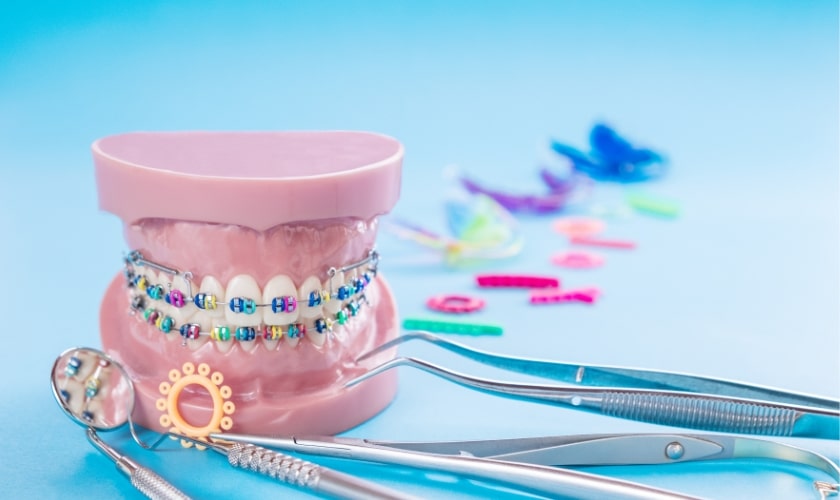Begin an enthralling trip through time as we uncover the fascinating fabric of orthodontics. This tale reveals the growth of a sector committed to producing not only smiles but stories of human creativity, from the ancient Egyptians’ crude attempts to reach dental perfection to the Renaissance sparks of invention and the cutting-edge technology characterizing the twenty-first century. Join us as we investigate the origins and landmarks that have turned orthodontics into an art, science, and monument to our never-ending search for the ideal smile.
What Is Orthodontics?
Orthodontics is a branch of dentistry that focuses on the diagnosis, prevention, management, and correction of misaligned teeth and jaws, as well as incorrect bite patterns. It also helps with dentofacial orthopedics. Almost half of the world’s population has severe malocclusions that necessitate orthodontic treatment. However, clear scientific proof supporting orthodontic treatment’s health advantages needs to be included. The major culprit is a childhood diet low in fresh fruits and vegetables, which results in narrower jaws with less room for teeth to emerge. Treatment can range from months to years and may include dental braces as well as jaw surgery. Treatment is typically initiated before adulthood to allow for simpler correction of pre-adult bones. If you have any orthodontic conditions, please get in touch with a professional. Orthodontists are always there to help you with your dental issues. Lend them a visit.
Ancient Beginnings:
Individuals have been dealing with the problem of overcrowded, uneven, and projecting teeth since the dawn of time. Evidence from Greek and Etruscan artifacts shows that attempts to cure this disease began around 1000 BC, with crude yet astonishingly well-crafted orthodontic tools. Various dental writers discussed and occasionally used a variety of techniques for the “regulation” of teeth in the 18th and 19th centuries. Orthodontics, as a contemporary science, dates back to the mid-1800s. Influential contributors to the field include Norman William Kingsley (1829–1913) and Edward Angle [8] (1855–1930). Angle developed the first basic technique for categorizing malocclusions, which is still in use today.
Middle Ages And Renaissance:
Orthodontic progress halted throughout the Middle Ages, with only minor advances. However, the Renaissance resurrected dental aesthetics. Notably, 18th-century French dentist Pierre Fauchard, who is known as the “father of modern dentistry,” revitalized the discipline. “The Surgeon Dentist,” his main work, represented a watershed moment by diving into numerous orthodontic procedures. Fauchard’s efforts during this period laid the groundwork for future advancements, reigniting interest in improving tooth alignment and laying the groundwork for the transformational developments that would occur over the next century.
The Birth Of Modern Orthodontics:
Orthodontics changed from correcting crooked teeth to treating malocclusions in the early twentieth century, with an emphasis on perfect occlusion and facial aesthetics. Following WWII, advances in cephalometric radiography revealed that poor jaw relations were the root cause of many malocclusions. Functional jaw orthopedics and extraoral force assessments were created to modify mandibular growth. The American Journal of Orthodontics was founded in 1915 with the goal of providing scientific goals and exact categorization systems. Lawrence F. Andrews’ discovery of perfect occlusion in permanent teeth inspired the development of the straight-wire appliance system, which revolutionized fixed orthodontic treatment.
Technological Revolution:
The twentieth century saw a period of technical advancement that transformed orthodontics into a highly complex profession. The advent of stainless steel and, subsequently, titanium transformed the materials used in braces, improving durability and patient comfort. Furthermore, the introduction of computer technology in the later half of the twentieth century cleared the door for computer-aided design (CAD) and three-dimensional imaging, allowing for more exact diagnosis and treatment planning.
Invisible Aligners And Beyond:
With the introduction of invisible aligners in the twenty-first century, orthodontic treatment underwent a paradigm change. Invisalign gained popularity as a more discrete alternative to conventional braces. These custom-made, removable aligners have changed the orthodontic experience, providing patients with greater comfort and flexibility. All modern procedures are available for your specific needs.
As we reflect on the journey of orthodontics, from ancient ingenuity to 21st-century marvels, it’s clear that this field transcends mere dental correction—it’s a narrative of human evolution. Orthodontics, a fusion of history and innovation, not only aligns teeth but shapes confidence and quality of life. With each era contributing to its rich tapestry, the future promises even more exciting chapters, where smiles become not just expressions but testaments to the enduring spirit of progress. In the realm of orthodontics, the journey never ends; it’s a perpetual odyssey toward perfecting the art of the smile.
